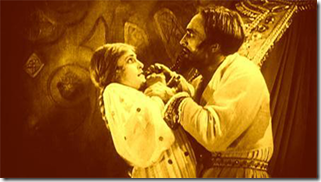Every year, the San Francisco Intl. Film Festival hosts a silent film event, where they match a movie–generally not one everyone has seen–with one or more musicians who enjoy a strong local following–but are not associated with silent film accompaniment.
This makes sense both culturally and financially. The event, always held at the Castro, attracts both silent film fans and fans of the musicians. The two groups mingle, and each is exposed to something new. And more people buy tickets, as well.
At least that’s the theory. Sometimes it works beautifully. Other times it doesn’t work at all.
Tuesday night, it worked beautifully. Let’s start with the movie:
With its exaggerated visuals and strong horror elements, Waxworks is German expressionism through and through. Directed by Paul Leni in 1924, it’s the only film I’ve seen with both major stars from the period: Emil Jannings and Conrad Veidt. Unfortunately, they have no scenes together. (Leni, Jannings, and Veidt all moved to Hollywood before the decade ended. Jannings and Veidt returned to Germany when sound came in. Veidt left for good after Hitler came to power. Jannings, to his immortal shame, did not.)
This anthology feature uses a simple framework to tell three different dark and  demented stories. A young writer takes a job in a wax museum, coming up with stories for the exhibits. Most of the film is made up of two such stories. The first stars Jannings as a sultan out to take a baker’s wife. The second stars Veidt (easily one of the best heavies cinema ever had) as the most evil Ivan the Terrible you can imagine. The third story, about Jack the Ripper (Werner Krauss) is nothing more than a chase.
demented stories. A young writer takes a job in a wax museum, coming up with stories for the exhibits. Most of the film is made up of two such stories. The first stars Jannings as a sultan out to take a baker’s wife. The second stars Veidt (easily one of the best heavies cinema ever had) as the most evil Ivan the Terrible you can imagine. The third story, about Jack the Ripper (Werner Krauss) is nothing more than a chase.
Like all anthology movies, it’s uneven. But I enjoyed it.
The music helped considerably. I know nothing about the musicians that took the stage–Mike Patton, Scott Amendola, Matthias Bossi, and William Winant–I can’t even tell you if they play together regularly. Their music–harsh, percussion-heavy, and usually without melody–would probably drive me crazy under any other circumstance. But it suited the film perfectly, adding to the creepy feel. They found plenty of ways to produce the sounds they wanted, including scat singing and rubbing a balloon. At home point, when Veidt rhythmically claps as wedding guests dance (only Veidt could make that threatening), one of the musicians beat two wooden sticks together for each clap.
The Festival got a hold a beautiful, tinted, 35mm print from Cineteca di Bologna. Some scenes were both tinted and toned–creating a two-color effect that until last night I had never seen on the big screen. There were a few scratches and a couple of moments of nitrate decomposition, but it was still a joy to watch. Although it was a German film and the print came from an Italian archive, the intertitles were in French. The Castro projected English translations as supertitles.
All told, a wonderful evening.
